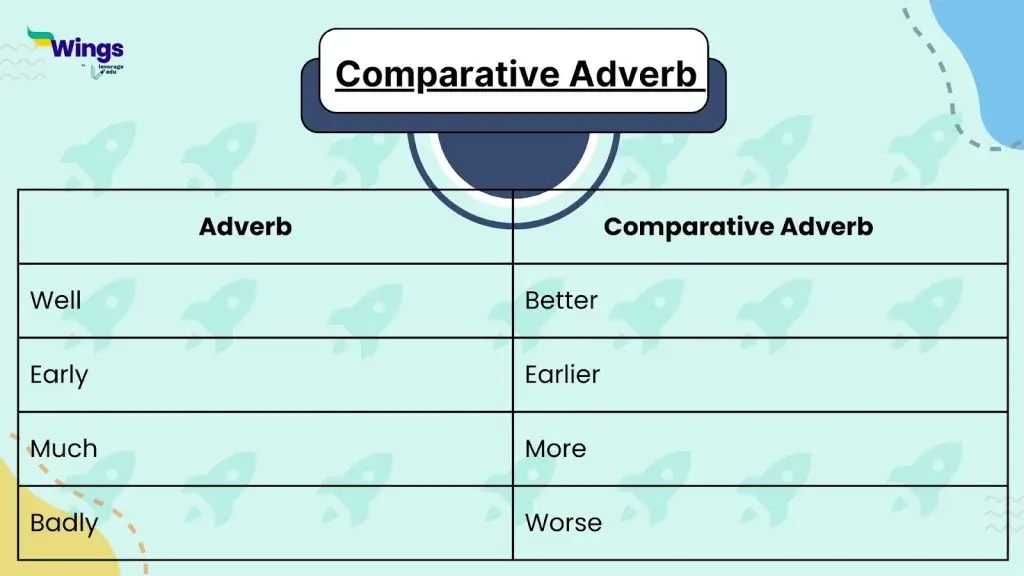Comparative Adverbs: English is a very advanced language which makes it a very complicated language to understand. Today, we will talk about Comparative Adverbs and how they are used to compare two actions or qualities. This is a very vague way of putting out this definition. But worry not as we will make things easier for you. In this blog, you will learn about Comparative Adverbs, and how they are used in the construction of sentences.
This Blog Includes:
What Are Comparative Adverbs?
As discussed above, Comparative adverbs which are also known as comparison adverbs are used in sentences to compare two different verb actions. They are usually used to show the intensity or decrease of an action than the other.
Also Read: Adverbs: Definition, Types, Use, Examples & Exercises
Types of Adverbs for Comparing
Comparing Adverbs are namely of two different types. These are known as comparative and superlative adverbs. These two are commonly used in writing.
- Comparative Adverb
- Superlative Adverb
Comparative Adverbs
A comparative adverb is used to compare two different verb actions. They show an increase or decrease in the action. Most adverbs form a comparative adverb by adding ‘more’ before the adverb.
Some of the most common comparative adverbs include ‘more’, ‘later’, ‘smarter’, ‘faster’, ‘later’ and many more like these. For Example:
- He runs more quickly than his friend.
- She speaks more fluently now.
How Do You Make a Comparative Adverb?
When making a comparative adverb, three main rules need to be followed.
- In case there are one-syllable adverbs, then add ‘er’ at the end. Take a look at the examples below for a reference.
- If there are two-syllable adverbs, then you can add ‘more’ in front of the adverb. For Example:
- Irregular Adverbs: There are a few adverbs which have an irregular form. Irregular adverbs are those which do not follow simple spelling rules, unlike regular adverbs. Here are some examples:

Here are some blogs you should check out:
| What are Proper Adjectives? | What are Superlative Adjectives? |
| What are Comparative and Superlative Adjectives? | Compound Adjectives |
Also Read: Guide on Relative Adverbs: Meaning, List, and Usage with Examples
Difference Between Comparative and Superlative Adverbs
The only difference between Comparative Adverbs and Superlative Adverbs is that the former is used in comparison with only two entities. Whereas, the latter is used in comparison with more than two entities. It can also include places, people or things.
Now, you must have all the necessary knowledge about both Comparative and Superlative Adverbs. Following this, we have compiled two short exercises to help you check your understanding.
Comparative Adverbs Exercises
Fill in the blanks with the correct comparative adverbs.
- She arrived ________ than expected. (early)
- Our new teacher explains the exercises ________ than our old teacher. (badly)
- The new plumber checked the tap_______than the old mechanic. (thoroughly)
- They called us _______ in the afternoon. (later)
- He hit is leg_______ than before. (hard)
- The Spanish athlete ran _______ than the other runners. (fast)
Check Out Other Blogs!
FAQs
We can use comparative adverbs to indicate change or make comparisons. Here is an example: I forget things more often nowadays.
Small is a ‘comparative adverb’ and the word ‘smallest’ or ‘smaller’ is a ‘superlative adverb’.
The adverb ‘more’ comes under the Adverbs of Degree. This means the intensity of something
To advance your grammar knowledge and read more informative blogs, check out our Learn English page and don’t forget to follow Leverage Edu.
 One app for all your study abroad needs
One app for all your study abroad needs















 60,000+ students trusted us with their dreams. Take the first step today!
60,000+ students trusted us with their dreams. Take the first step today!

